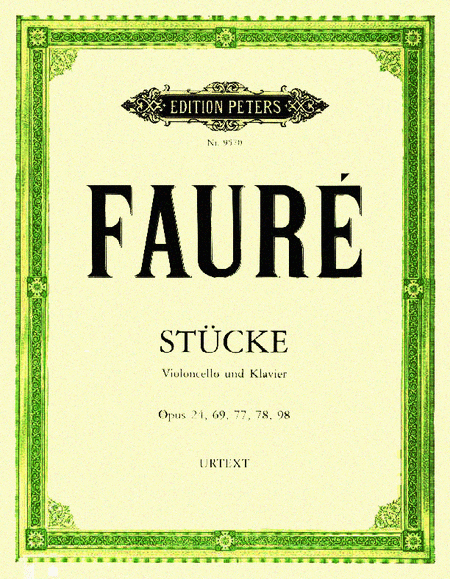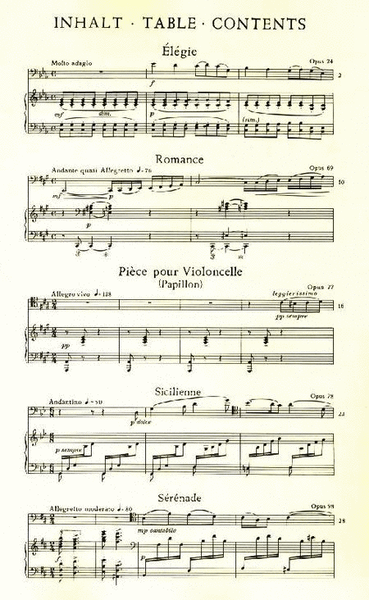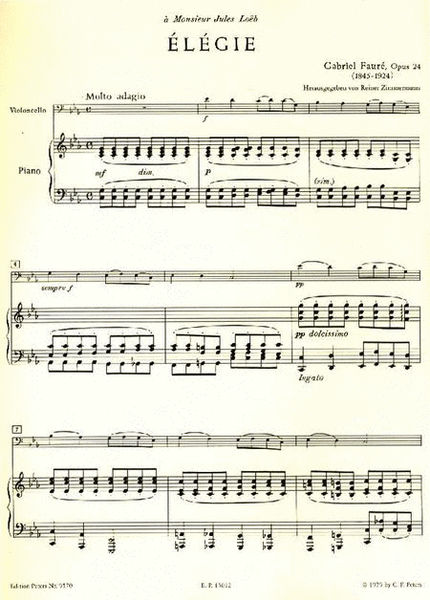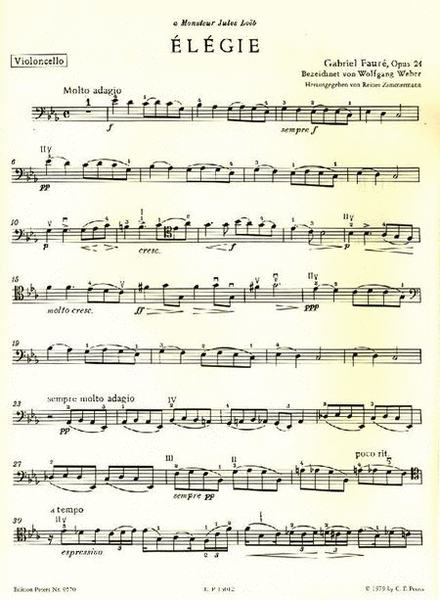Pieces for Violoncello & Piano
Details
Description
SKU: PE.EP9570
Composed by Gabriel Faure. Cello & Piano. Sheet Music. Edition Peters #EP9570. Published by Edition Peters (PE.EP9570).Concluding Remarks: Gabriel Faure (1845-1924) is one of the most significant French composers of the second half of the 19th and the beginning of the 20th century. His main work consists of piano, vocal and chamber music compositions.Gabriel Faure was trained in Paris, at the Louis Niedermeyer School of Church Music, his teachers being Niedermeyer and Camille Saint-Saens, became choir-master (1877) and subsequently organist at the Madeleine (1896-1905). He took charge, in 1896, of a composition class at the Paris Conservatory and was its Director from 1905-1920. Among his pupils were Maurice Ravel, Charles Koechlin, Florent Schmitt, Roger Ducasse and Nadia Boulanger.The foundation of the Societe Nationale de Musique by Saint Saens and Bussine in 1871 encouraged Faure to write chamber music. Together with Saint-Saens, Edouard Lalo and Cesar Franck, he took part in the revival of French chamber music.Faure always showed a predilection for the Violoncello. Apart from the two fine Sonatas, Op. 109 and 117 which he composed towards the end of his life, the special position that he assigned to that instrument in his chamber music compositions mail be seen, for example, in ti-12 adagio of the first Piano Quartet, Op. 15, at the beginning and in the andante of the Piano Trio, Op. 120, and in the finale of the String Quartet, Op. 121; the significant function of the cello however, should also be stressed in connection with his orchestral compositions. This specific feature might be explained by his training as organist and performer of church music (the cello also functions as an organ pedal), but it is known that the composer bad a particular preference for the basses in his harmony. "Come on, basses!" was one of his frequent utterances. It is therefore not surprising that Faure should have composed various short works in the course of his life which may he regarded as precursors of the two later sonatas of his maturity.The first of these shorter compositions is the famous Eleie, Op. 24. This was probably the work first performed on June 21st, 1880 in Saint-Saens' salon of which Faure wrote to his publisher, Julien Hamelle: "my cello piece had an excellent reception", adding: "it greatly encourages me to make it into a complete sonata". This sonata project explains the wealth of content and the A-B-A-form of the work;.but the cello sonata was not completed. The work was first printed in 1883 with a dedication to Jules Loeb, professor of cello at the Paris Conservatory, who gave the first public performance on December 15th, 1883 at the Societe Nationale de Musique. In 1895 Faure made a version with orchestral accompaniment. As soon as it was published, the Elegie was so successful that Hamelle immediately ordered a new work, intended as a virtuoso pendant to the Elegie. Faure set about composing the piece with little enthusiasm; the new work was mentioned in a contract dated September 25th, 1884, but its publication was delayed for a long time since the composer had a quarrel with the publisher concerning the title. It is known that Faure preferred abstract titles without extra-musical connotations. This, however, was of no concern to the publisher, who knew the preference of the public for visual titles. Faure insisted on the plain title Piece for Violoncello, whereas Hamelle for his part proposed Libellules (dragonflies), a title which was also mentioned in the contract. Fourteen years passed before the composer unwillingly consented to the title Papillon (butterfly), which he diskliked intensely. He at least succeeded in retaining Piece for Violoncello, Op. 77 as sub-title. This eloquent and light composition also met with wide response among cellists, although its musical interest is somewhat limited. By 1898, the year of its belated publication, it scarcely correspondend in style with Faure's works of this period, which is characterised by works as the 7th Nocturne, Op. 74 and the incidental music of Pelleas et Melisande, Op. 80. The great passionate phrase of the second theme is in fact much closer to the 4th Nocturne, Op. 36 (1884), composed during the same period.In 1893 Faure was commissioned to write incidental music for Moliere's Le Bourgeois Gentilhomme, and for this he composed the Sicilienne for small orchestra, the posthumously published Serenade for voice and, it would seem, a Menuet for small orchestra which remains unpublished. The project, apparently, was not realised, but Faure was clearly pleased with the Sicilienne, since he used it again in 1898 for his incidental music to Maurice Maeterlinck's Pelleas et Melisande on the occasion of the first performance in London, where it introduced the second act (scene by the well). In the same year, it was published separatly in a version for cello and piano by Metzler & Co. in London and, simultaneously, by Hamelle in Paris. It is dedicated to the British cellist William Henry Squire, who recorded it in 1925. As for the orchestral version of this wellknown piece, it was omitted when Faure compiled a symphonic suite from the Pelleas music, which appeared in 1901; but at the express request of the composer it was printed in 1909 and included in the Suite, Op. 80.The Romance in A, Op. 69 should not be confused with the transcription for cello (also in A) of the third Romance sans Paroles, Op. 17 (A flat in the original piano version). This Romance, Op. 69 is one of the best of Faure's compositions for cello. It was probably written in 1894, a year in which many of Faure's master works were created: the cycle of the songs La Bonne Chanson, Op. 61, the 6tb Nocturne, Op. 63, the 5tb Barcarolle, Op. 70 and the songs Soir and Prison, Op. 83 were all composed during that year. The Romance in A begins and ends in a Brahmsian chiaroscuro which suddenly flares up und then unfolds in a long and flexible phrase accompanied by surging piano arpeggios. Its exhaustable lyricism has something of the passionate Elan of La Bonne Chanson, Faure performed it for the first time in Geneva on November 14th, 1894, with Adolf Rehberg. The work is dedicated to the cellist Jules Griset, who used to arrange chamber music and oral concerts at his home (Chabrier wrote his Ode to Music for him.) The autograph, it may be noted, in inscribed Andante and Op. 63. It was transcribed by Faure into a version for cello and organ which was never published.The last of the short pieces for cello is the Serenade, Op. 98, composed for the young Pablo Casals, who had become acquainted with , Faure as early as 1901, the year of his Paris debut, when he played the P-Mgie with the composer conducting. The Serenade was published in 1908 by Heugel; this composition reveals the unusual care with which Faure composed even the smallest of his works; exceptionally for Faure, it is full of humour and fantasy, with ornaments reminiscent of the harpsichord music of the 18th century. Yet this Serenade is by no means a mere pastiche: it is harmonically daring and at times wilfully abrasive. Beneath the irony, one has a glimpse of the distilled, austere style of the last works, so remote from the romanticism of the Elegie."The Serenade", Casals wrote to Faure, "ist delightful and every time I play it, it seems new to me in its beauty." In fact however, Casals does not seem to have played it very often, giving preference to the questionable transcription of the piano song Apres un Reve which he had himself published in 1910. For this reason the Serenade has remained little known, despite perhaps because of, its originality.Translated by Eva Breck and Stuart Thync.Paris, Autumn 1977 Jean-Michel Nectoux.
Song List (4)
- Romance A-Dur op. 69 -fur Violoncello und Klavier-
- Piece pour Violoncelle (Papillon) A-Dur op. 77 -fur Violoncello und Klavier-
- Sicilienne g-Moll op. 78 -fur Violoncello und Klavier-
- Serenade h-Moll op. 98 -fur Violoncello und Klavier-




 Share
Share